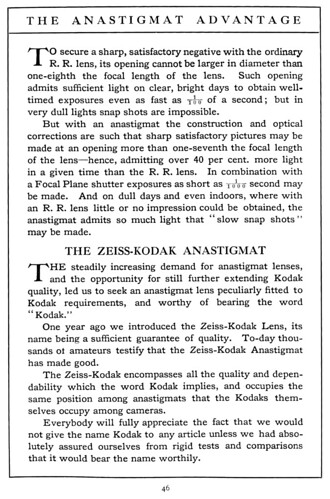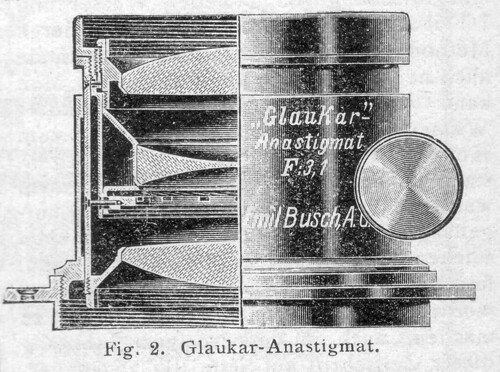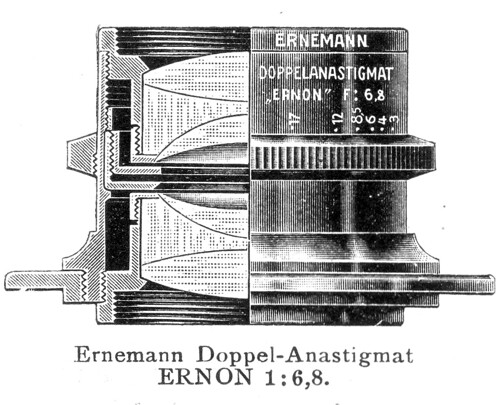Difference between revisions of "Anastigmat"
m (simpler wording) |
m (Moved Glossary to the top of the page) |
||
| (One intermediate revision by one other user not shown) | |||
| Line 1: | Line 1: | ||
| + | {{glossary}} | ||
{{Flickr image | {{Flickr image | ||
| image_source=http://www.flickr.com/photos/mario_groleau/5231573741/in/pool-camerawiki/ | | image_source=http://www.flickr.com/photos/mario_groleau/5231573741/in/pool-camerawiki/ | ||
| Line 8: | Line 9: | ||
}} | }} | ||
| − | Astigmatism is a lens fault that causes a point of the subject | + | Astigmatism is a lens fault that causes a point of the subject to appear as a line on the focal plane. In anastigmatic lenses the fault is corrected by a careful combination of lens elements. |
| − | + | A correction of astigmatism in photographic [[lens]]es was demonstrated in 1889 when [[Paul Rudolph]] developed the first Anastigmat lens for [[Carl Zeiss]]. In 1890 this Zeiss lens was named ''[[Protar]]''. A fundamental anastigmat lens formula is Dennis Cooke's [[Cooke triplet]] of 1893 which combined color correction with anastigmatism. Three airspaced lenses offer a designer just enough degrees of freedom to correct all these basic aberrations. Other remarkable anastigmatic lenses were [[Emil Busch]]'s fast F3.1 ''Glaukar'' anastigmat of 1910 and [[Ernemann]]'s fast F2.0 ''Ernostar'' lenses of the mid-1920s. | |
| − | By the mid 20th century, correction for astigmatism was the norm on better cameras, as designs moved on to 4- to 7-element standard lenses. Lens descriptors then highlighted other aspects, such as maximum aperture or "Color" lenses (i.e. achromatic and antireflection-coated). After 1945 | + | By the mid 20th century, correction for astigmatism was the norm on better cameras, as designs moved on to 4- to 7-element standard lenses. Lens descriptors then highlighted other aspects, such as maximum aperture or "Color" lenses (i.e. achromatic and antireflection-coated). After 1945 a labeling of "anastigmat" was generally reserved for lower-end lens options, typically of the Cooke triplet type. |
{{Flickr_image | {{Flickr_image | ||
| Line 38: | Line 39: | ||
The [[Turner-Reich Anastigmat]] of 1896 was a remarkable symmetrical construction, consisting of two five-element (!) lens groups. | The [[Turner-Reich Anastigmat]] of 1896 was a remarkable symmetrical construction, consisting of two five-element (!) lens groups. | ||
| − | |||
| − | |||
==Links== | ==Links== | ||
Latest revision as of 03:13, 22 March 2023

|
| 1910 Kodak catalog page scanned by Mario Groleau (Image rights) |
Astigmatism is a lens fault that causes a point of the subject to appear as a line on the focal plane. In anastigmatic lenses the fault is corrected by a careful combination of lens elements.
A correction of astigmatism in photographic lenses was demonstrated in 1889 when Paul Rudolph developed the first Anastigmat lens for Carl Zeiss. In 1890 this Zeiss lens was named Protar. A fundamental anastigmat lens formula is Dennis Cooke's Cooke triplet of 1893 which combined color correction with anastigmatism. Three airspaced lenses offer a designer just enough degrees of freedom to correct all these basic aberrations. Other remarkable anastigmatic lenses were Emil Busch's fast F3.1 Glaukar anastigmat of 1910 and Ernemann's fast F2.0 Ernostar lenses of the mid-1920s.
By the mid 20th century, correction for astigmatism was the norm on better cameras, as designs moved on to 4- to 7-element standard lenses. Lens descriptors then highlighted other aspects, such as maximum aperture or "Color" lenses (i.e. achromatic and antireflection-coated). After 1945 a labeling of "anastigmat" was generally reserved for lower-end lens options, typically of the Cooke triplet type.

|
| typical Aldis f/7.7 Anastigmat image by John-Henry Collinson (Image rights) |

|

| ||||
| Anastigmatic lenses of 1910: a Glaukar F:3,1 Anastigmat of Emil Busch and an Ernon F:6,8 Double Anastigmat of Ernemann | |||||

| |||||
| 10, 11, symmetrical and 12, half-symmetrical double anastigmats of Goerz (Dagor), Rietzschel and Zeiss |
13, 14, asymmetrical anastigmats and 15, Triple Anastigmat of Goerz, Zeiss and Voigtländer (Heliar) | ||||
The Turner-Reich Anastigmat of 1896 was a remarkable symmetrical construction, consisting of two five-element (!) lens groups.
Links
- Flickr gallery Protar shows the original Zeiss Anastigmat, the Protar variants and shots made with these lenses